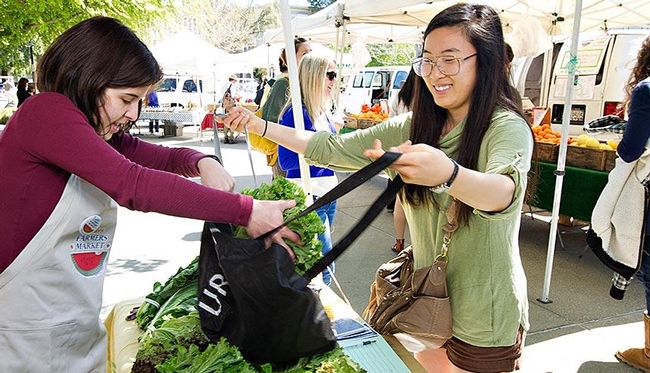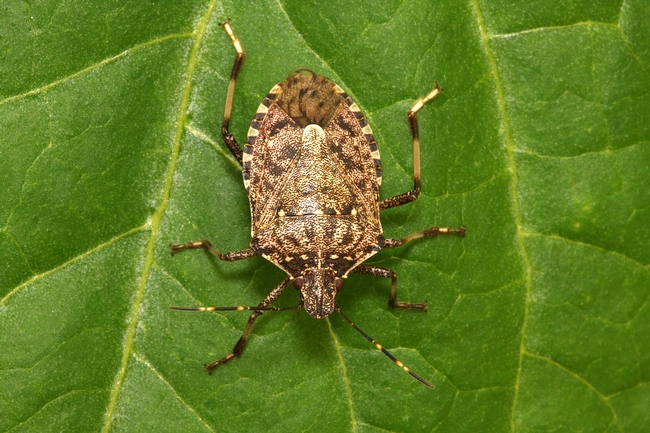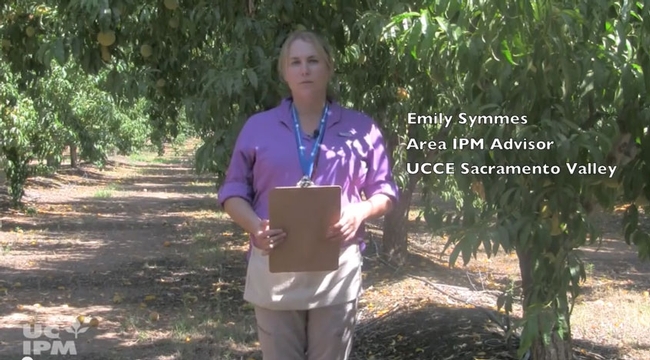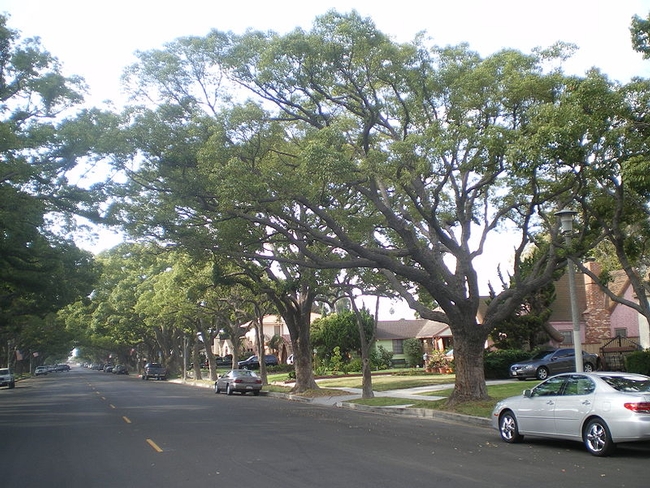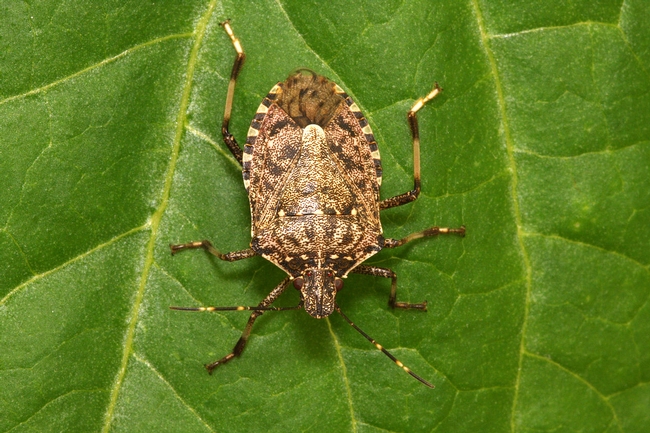Posts Tagged: Chuck Ingels
Direct-marketing farms have double the regional impact
Sacramento-area farmers and ranchers who sell their products directly to consumers generate twice as much regional economic impact per dollar of output as do area food producers who don't engage in direct marketing, reports a UC Davis agricultural economist and a team of UC Cooperative Extension researchers.
The newly released study of the four Sacramento region counties of El Dorado, Placer, Sacramento and Yolo found that direct-marketing food producers had a regional output multiplier of 1.86 compared to just 1.42 for producers not involved in direct marketing.
Direct-marketing channels include farmers markets, roadside farm stands and community-supported agriculture programs that provide consumers with regular deliveries of farm products.
“The direct marketers make up a relatively small part of the Sacramento region's agricultural sector, but this study demonstrates that these food producers generate both economic and qualitative benefits for the region,” said study leader Shermain Hardesty, a UC Cooperative Extension specialist in the UC Davis Department of Agricultural and Resource Economics.
“It's important that the economic contributions of direct-marketing farmers and ranchers be taken into consideration so that regional policies can be enhanced to support and nurture the growth of these food producers,” Hardesty said.
The regional economic impacts identified in the study are threefold: revenue received directly by the agricultural producer; a ripple effect when the food producer purchases inputs in the region; and a secondary ripple when the producer and the suppliers of goods and services to the producer, in turn, spend more money in the region on household goods and services.
The report, along with separate economic impact reports specifically for El Dorado, Placer and Yolo counties, is available online.
Sacramento region direct marketers
In the four-county Sacramento region, direct-marketing food producers are a relatively small segment of the total agricultural sector, accounting for 19 percent of the region's farms and only 4 percent of its agricultural production.
The direct-marketing farm operations tend to be smaller and more labor-intensive, and source more of their inputs locally than do nondirect-marketing operations in the area.
The new study was based on economic information gathered from 88 local farmers and ranchers, including 31 vegetable farmers, 48 orchard or vineyard growers and nine livestock producers, each of whom generated at least $1,000 in annual sales from marketing directly to consumers.
After the data were collected, they were incorporated into an economic modeling program to estimate the economic impacts of producers engaged in direct marketing.
Study highlights
Other findings from the report include:
• Sacramento region direct-market producers averaged just $164,631 in one year of sales compared to $568,105 for those not engaged in direct marketing.
• Seventy-three percent of the direct marketers also sold through wholesale channels.
• Overall, the direct-market producers generated 44 percent of their total revenues through direct-marketing channels, 55 percent through wholesale channels and 1 percent through commodity markets.
• For every $1 million of output, the direct-market producers generated a total of 31.8 jobs in the Sacramento region while the nondirect-market producers generated only 10.5 jobs.
• Direct marketers purchased 89 percent of their inputs within the region while the nondirect-market producers purchased 45 percent of their inputs in the region. This local sourcing of inputs was the primary factor responsible for the direct-market producers having a greater economic impact on the region than nondirect-market producers.
Collaborators and funding
Hardesty collaborated on the study with Libby Christensen, Erin McGuire and Gail Feenstra, all of UC Davis; and Chuck Ingels, Jim Muck, Julia Boorinakis-Harper, Cindy Fake and Scott Oneto, all with the UC Cooperative Extension.
Funding for the study was provided by the University of California Division of Agriculture and Natural Resources Competitive Grants Program.
Brown marmorated stink bugs expected to have a 'banner year'
The California population of brown marmorated stink bugs, a pest introduced into the state from its native Asia, continues to spread and increase in and around Sacramento, said a UC Agriculture and Natural Resources (UC ANR) expert who appeared today on Capitol Public Radio's Insight program with Beth Ruyak.
Chuck Ingels, UC ANR Cooperative Extension advisor in Sacramento County, said BMSB was first spotted in 2013 in Sacramento and each year the numbers have grown. This year, the warm spring gave BMSB a head start, portending significant population growth in August and September 2015.
"We're very concerned about tree crops, tomatoes, peppers, corn, beans and other crops," Ingels said. On a bright note, he said California farms do not have forests surrounding them like farmers back East, where growers have been dealing with BMSB since the the mid-1990s. "BMSB is an arboreal species. They live in trees and then come into the farm. We're not sure how much of a problem it will be on farms here (in California)."
Ruyak asked whether any control solutions can be found in the pest's native territory or from farmers back East.
"Growers are using pesticides back East," Ingels said. "There is a parasitoid from China that is under study in labs to see if they pose a problem for native stink bugs and other bugs."
One possible solution for dealing with the pests in gardens is planting sunflowers. Because BMSB are strongly attracted to sunflowers, they may draw the pests away from other crops and allow gardeners to monitor the BMSB presence. On the other hand, sunflowers may actually attract BMSB to the garden, where they could feed on vegetable crops.
BMSB feeds with a mouthpart called a "proboscis," stinging developing fruit 1/4 to 3/8 inch deep and sucking out its juices. As the fruit ripens, it hardens and deforms, becoming inedible.
Read more about BMSB, how to identify it, and methods to manage it around homes and gardens in the UC IPM Pest Note: Brown Marmorated Stink Bug.
New videos from UC IPM help stone fruit growers and PCAs tackle pest problems
Spider mites, fruit moth and twig borer larvae, aphids, and bark cankers are just a few pests that can wreak havoc on stone fruit trees. With spring well underway and trees in full bloom and beginning to develop fruit, it's time to monitor and take action before these pests get out of hand.
The UC Agriculture and Natural Resources Statewide Integrated Pest Management (IPM) program teamed up with UC ANR farm advisors to develop a series of how-to videos that can help growers and pest control advisers monitor for pests and damage and determine if and when treatment is needed.
In one video, Sacramento Area IPM advisor Emily Symmes gives a brief overview of how to monitor for webspinning spider mites. Spider mites build up in stone fruit trees as the weather warms up. Late spring through summer is the ideal time to monitor for mites and their damage, which includes leaf stippling and webbing. If mites build up too much, leaves can drop, fruit may not fully develop, and branches and fruit can be exposed to sunburn.
Shoot strikes, or dead drooping leaf tips, are often seen on young peach and nectarine trees. In a second video, UC ANR farm advisor Janine Hasey explains how to monitor for shoot strikes and how to distinguish the culprits, Oriental fruit moth and peach twig borer. Although Oriental fruit moth and peach twig borer can bore into both foliage and fruit, they cause the most devastating damage by feeding on fruit. Early season monitoring and treatment can prevent future fruit loss.
In plum and prune orchards, leaf curl aphids and mealy plum aphids cause leaves to curl and become distorted. Aphids produce honeydew, which can lead to the development of sooty mold, causing fruit to crack and blacken. Aphids are often present when leaves start to grow. In his video, Rick Buchner, UC ANR farm advisor for Tehama County, discusses how to monitor for aphids and explains how to decide when treatment is warranted.
In a final video, UC ANR farm advisor Chuck Ingels teaches how to distinguish Phytophthora root and crown rot from bacterial canker. The two diseases are often confused because they both cause bark cankers. Phytophthora root and crown rot is confined to the lower trunk, but when a bacterial canker infection occurs in the tree trunk, the diseases can often be confused. Bacterial canker can be confirmed by cutting away the outer bark and looking for characteristic red flecks on the inner bark. Correct identification of these diseases will help in choosing a management strategy.
You can find all of these how-to videos on the UC IPM video library page. For specific information about managing pests in stone fruits or other crops, see the Pest Management Guidelines.
Proper winter season tree care during a drought
California's drought is having a visible impact on lawns throughout the state as homeowners reduce their outdoor watering. Lawns can be brought back to life relatively quickly, but once a tree dies, its loss is irreversible.
As the amount of sunlight falling on trees is reduced with the change in the seasons, trees go into dormancy and require less water than during the hot summer months. But in exceptionally dry conditions, a tree may not have enough stored moisture to survive until drought conditions improve. Tree advocates and water officials today urged homeowners to educate themselves on effective tree care to ensure their trees' survival in the months ahead – especially if California's extended dry period continues this winter.
Representatives of the Sacramento Tree Foundation, California Center for Urban Horticulture (CCUH) at UC Davis, UC Cooperative Extension and the California Department of Water Resources (DWR) say a return of normal rainfall this winter might be enough to sustain trees without special care and watering. However, with no way to know how long the current drought will continue, the advocates said knowing when and where to water a tree can be the difference between its life and death.
“We are seeing locations in California where trees are dying because they haven't been watered adequately,” said CCUH Director Dave Fujino. “While homeowners are trying to save water by letting lawns die, they need to continue watering their nearby trees.”
Chuck Ingels, UC Cooperative Extension horticulture advisor, urged homeowners to follow these steps:
- Dig into the soil 6 to 8 inches at a tree's drip line – the area immediately below the widest part of the leaf canopy; if the soil feels dry and crumbly, it needs water.
- Apply water slowly and uniformly using low-volume application equipment, such as a soaker hose that circles the tree at the drip line. Allow water to saturate the soil to a depth of 8 to 12 inches.
- Allow the soil to dry between waterings; for most mature trees, one or two deep waterings per month is adequate. Fewer waterings – and perhaps none – are needed during the cooler and potentially wet winter months.
- Add mulch (leaves or wood chips) between the trunk and drip line to retain the soil's moisture.
- Reduce competition for water by removing weeds and grass within 4 feet of a tree's trunk.
Anne Fenkner, Greenprint Regional Coordinator, Sacramento Tree Foundation, said trees are essential to the health and beauty of residences and entire communities throughout the state. “Trees provide food for people and animals and shade that helps make hot climates livable,” she said. “We owe it to ourselves, our children, their children and the trees themselves to help them get through this extraordinarily dry period. When water supplies are limited, priority should be given to trees, then shrubs and perennials and lastly to lawn and annuals.”
Julie Saare-Edmonds, DWR's Landscape Program Manager, said Californians are responding to the call in January by Governor Edmund G. Brown Jr. to reduce their water usage by 20 percent.
But if a homeowner has allowed a lawn to dry up during the drought, trees growing in that lawn may not be getting enough water and may need more to help them transition into winter dormancy.
Anne Fenkner, Sacramento Tree Foundation, said trees have varying water needs depending on their species, age, size, slope of the ground beneath them and other factors. Homeowners can nurture their trees and improve their health by understanding tree care principles:
- Older established trees may be starved for water as well as younger trees. The low rainfall last winter did not replenish the soil moisture adequately and they may need a moisture boost before winter.|
- Avoid fertilizing trees now; it will stimulate new growth at the wrong time of year.
- When planting new trees, choose species wisely. Consult a local urban forestry group such as the Sacramento Tree Foundation or check the Arboretum All-Stars list at UC Davis. We don't know how long the drought will last, so consider selecting drought-resistant varieties and delaying planting until drought conditions improve. If the drought worsens in 2015, investments in new trees may be lost.
- Improve the quality of the soil in which the trees grow. Aerate lawns so the roots of mature trees have good access to water and oxygen.
- Consult the UC Cooperative Extension Master Gardeners or a certified arborist if you have questions about the health of a mature tree.
Additional advice on caring for trees can be found at these websites:
- Statewide UC Master Gardener Program, http://camastergardeners.ucanr.edu/
- California Center for Urban Horticulture, http://ccuh.ucdavis.edu/public
- Sacramento Tree Foundation, http://www.sactree.com/
- California ReLeaf, http://californiareleaf.org/
- California Urban Forests Council, http://www.caufc.org/
- Sacramento Master Gardeners, http://ucanr.edu/sites/sacmg/Drought
- UC Davis Arboretum All-Stars, http://arboretum.ucdavis.edu/arboretum_all_stars.aspx
- CAL FIRE, http://www.fire.ca.gov/resource_mgt/resource_mgt_urbanforestry.php
At a press availability on Tuesday, Oct. 28, tree advocates, water officials and a UC Cooperative Extension environmental horticulture expert will urge homeowners to educate themselves on effective tree care to ensure their trees' survival in the months ahead – especially if California's extended dry period continues this winter. With exceptionally dry conditions, a tree may not have enough stored moisture to survive until California has relief from the drought.
| WHAT: | Presentations on tree care by Sacramento Tree Foundation, University of California Cooperative Extension and the California Department of Water Resources. Event will show how to keep trees healthy during the drought and prepare them for the cooler winter season. Demonstrations will include determining if soil is sufficiently wet, the importance of mulch, identifying a tree's drip line and why it's important to slowly add water there. |
| WHEN: | 9:30 to 10 a.m., Tuesday, October 28, 2014 |
| WHERE: | 3457 V Street, Sacramento, Calif. (Residential home across street from Sacramento High School, one-half block east of 34th Street just south of Highway 50 and southeast of downtown Sacramento.) |
| SPEAKERS: | Anne Fenkner, Greenprint Regional Coordinator, Sacramento Tree Foundation Chuck Ingels, Environmental horticulture advisor, UC Cooperative Extension in Sacramento County Julie Saare-Edmonds, Department of Water Resources Landscape Program Manager |
Nightmare in midtown: Brown marmorated stink bugs
A population of invasive brown marmorated stink bugs have settled in Sacramento's mid-town, a development that Sacramento Bee writer Debbie Arrington says is "worthy of a Halloween creature feature."
"Wow, I'm being overwhelmed with calls about brown marmorated stink bugs getting into people's home, as well as restaurants and businesses," said Chuck Ingels, UC Cooperative Extension advisor in Sacramento County. "It's that time of year again!"
When days get shorter and cooler, the BMSB start looking for a place to spend the winter. Frequently, that's inside homes and buildings.
Ingels told the reporter he is keeping track of the BMSB invasion. Residents are asked to fill in an online survey to report BMSB finds. For identification help, residents may deliver BMSB in a sealed plastic bag or container to the UCCE office, 4145 Branch Center Road, Sacramento, or they can email clear photos to cesacramento@ucanr.edu.
Ingels said fairly large populations of BMSB have been found in Citrus Heights near Auburn Boulevard and River Park north and west of CSU Sacramento.
"Most of the others are single finds," he said.
For more information on BMSB identification and management, read a Pest Note posted by the UC Integrated Pest Management program.

